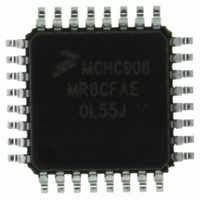MCHC908MR8CFAE Freescale Semiconductor, MCHC908MR8CFAE Datasheet - Page 205

MCHC908MR8CFAE
Manufacturer Part Number
MCHC908MR8CFAE
Description
IC MCU 8K FLASH 8MHZ PWM 32-LQFP
Manufacturer
Freescale Semiconductor
Series
HC08r
Datasheet
1.MCHC908MR8VFAE.pdf
(372 pages)
Specifications of MCHC908MR8CFAE
Core Processor
HC08
Core Size
8-Bit
Speed
8MHz
Connectivity
SCI
Peripherals
LVD, POR, PWM
Number Of I /o
16
Program Memory Size
8KB (8K x 8)
Program Memory Type
FLASH
Ram Size
256 x 8
Voltage - Supply (vcc/vdd)
4.5 V ~ 5.5 V
Data Converters
A/D 7x10b
Oscillator Type
Internal
Operating Temperature
-40°C ~ 85°C
Package / Case
32-LQFP
Controller Family/series
HC08
No. Of I/o's
16
Ram Memory Size
256Byte
Cpu Speed
8MHz
No. Of Timers
2
Rohs Compliant
Yes
Processor Series
HC08MR
Core
HC08
Data Bus Width
8 bit
Data Ram Size
64 B
Interface Type
SCI, SPI
Maximum Clock Frequency
8 MHz
Number Of Programmable I/os
32
Number Of Timers
4
Operating Supply Voltage
0 V to 5 V
Maximum Operating Temperature
+ 85 C
Mounting Style
SMD/SMT
Development Tools By Supplier
FSICEBASE, M68CBL05CE
Minimum Operating Temperature
- 40 C
On-chip Adc
8 bit, 8 Channel
Lead Free Status / RoHS Status
Lead free / RoHS Compliant
Eeprom Size
-
Lead Free Status / Rohs Status
Details
Available stocks
Company
Part Number
Manufacturer
Quantity
Price
Company:
Part Number:
MCHC908MR8CFAE
Manufacturer:
Freescale Semiconductor
Quantity:
10 000
- Current page: 205 of 372
- Download datasheet (4Mb)
11.4.3 Output Compare
MC68HC908MR8 — Rev 4.1
Freescale Semiconductor
NOTE:
has occurred by enabling input capture interrupts or by polling the status
flag bit.
The free-running counter contents are transferred to the TIMA channel
status and control registers TACHxH and TACHxL (see
Channel
whether the TIMA channel flag (CH0F–CH1F in the TASC0–TASC1
registers) is set or clear. When the status flag is set, a CPU interrupt is
generated if enabled. The value of the count latched or captured is the
time of the event. Because this value is stored in the input capture
register two bus cycles after the actual event occurs, user software can
respond to this event at a later time and determine the actual time of the
event. However, this must be done prior to another input capture on the
same pin; otherwise, the previous time value will be lost.
By recording the times for successive edges on an incoming signal,
software can determine the period and/or pulse width of the signal. To
measure a period, two successive edges of the same polarity are
captured. To measure a pulse width, two alternate polarity edges are
captured. Software should track the overflows at the 16-bit module
counter to extend its range.
Another use for the input capture function is to establish a time
reference. In this case, an input capture function is used in conjunction
with an output compare function. For example, to activate an output
signal a specified number of clock cycles after detecting an input event
(edge), use the input capture function to record the time at which the
edge occurred. A number corresponding to the desired delay is added to
this captured value and stored to an output compare register (see
11.10.5 TIMA Channel
output compares are referenced to the same 16-bit modulo counter, the
delay can be controlled to the resolution of the counter independent of
software latencies.
Reset does not affect the contents of the input capture channel register
(TACHxH–TACHxL).
With the output compare function, the TIMA can generate a periodic
pulse with a programmable polarity, duration, and frequency. When the
Registers) on each proper signal transition regardless of
Timer Interface A (TIMA)
Registers). Because both input captures and
Timer Interface A (TIMA)
Functional Description
11.10.5 TIMA
Technical Data
205
Related parts for MCHC908MR8CFAE
Image
Part Number
Description
Manufacturer
Datasheet
Request
R
Part Number:
Description:
Manufacturer:
Freescale Semiconductor, Inc
Datasheet:
Part Number:
Description:
Manufacturer:
Freescale Semiconductor, Inc
Datasheet:
Part Number:
Description:
Manufacturer:
Freescale Semiconductor, Inc
Datasheet:
Part Number:
Description:
Manufacturer:
Freescale Semiconductor, Inc
Datasheet:
Part Number:
Description:
Manufacturer:
Freescale Semiconductor, Inc
Datasheet:
Part Number:
Description:
Manufacturer:
Freescale Semiconductor, Inc
Datasheet:
Part Number:
Description:
Manufacturer:
Freescale Semiconductor, Inc
Datasheet:
Part Number:
Description:
Manufacturer:
Freescale Semiconductor, Inc
Datasheet:
Part Number:
Description:
Manufacturer:
Freescale Semiconductor, Inc
Datasheet:
Part Number:
Description:
Manufacturer:
Freescale Semiconductor, Inc
Datasheet:
Part Number:
Description:
Manufacturer:
Freescale Semiconductor, Inc
Datasheet:
Part Number:
Description:
Manufacturer:
Freescale Semiconductor, Inc
Datasheet:
Part Number:
Description:
Manufacturer:
Freescale Semiconductor, Inc
Datasheet:
Part Number:
Description:
Manufacturer:
Freescale Semiconductor, Inc
Datasheet:
Part Number:
Description:
Manufacturer:
Freescale Semiconductor, Inc
Datasheet:











